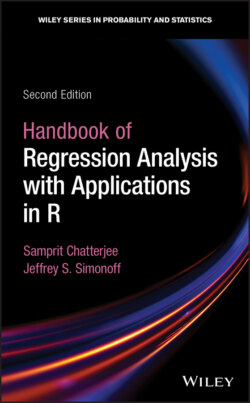Читать книгу Handbook of Regression Analysis With Applications in R - Samprit Chatterjee - Страница 17
1.2.2 ESTIMATION USING LEAST SQUARES
ОглавлениеThe true regression function represents the expected relationship between the target and the predictor variables, which is unknown. A primary goal of a regression analysis is to estimate this relationship, or equivalently, to estimate the unknown parameters . This requires a data‐based rule, or criterion, that will give a reasonable estimate. The standard approach is least squares regression, where the estimates are chosen to minimize
(1.2)
Figure 1.2 gives a graphical representation of least squares that is based on Figure 1.1. Now the true regression line is represented by the gray line, and the solid black line is the estimated regression line, designed to estimate the (unknown) gray line as closely as possible. For any choice of estimated parameters , the estimated expected response value given the observed predictor values equals
FIGURE 1.2: Least squares estimation for the simple linear regression model, using the same data as in Figure 1.1. The gray line corresponds to the true regression line, the solid black line corresponds to the fitted least squares line (designed to estimate the gray line), and the lengths of the dotted lines correspond to the residuals. The sum of squared values of the lengths of the dotted lines is minimized by the solid black line.
and is called the fitted value. The difference between the observed value and the fitted value is called the residual, the set of which is represented by the signed lengths of the dotted lines in Figure 1.2. The least squares regression line minimizes the sum of squares of the lengths of the dotted lines; that is, the ordinary least squares (OLS) estimates minimize the sum of squares of the residuals.
In higher dimensions (), the true and estimated regression relationships correspond to planes () or hyperplanes (), but otherwise the principles are the same. Figure 1.3 illustrates the case with two predictors. The length of each vertical line corresponds to a residual (solid lines refer to positive residuals, while dashed lines refer to negative residuals), and the (least squares) plane that goes through the observations is chosen to minimize the sum of squares of the residuals.
FIGURE 1.3: Least squares estimation for the multiple linear regression model with two predictors. The plane corresponds to the fitted least squares relationship, and the lengths of the vertical lines correspond to the residuals. The sum of squared values of the lengths of the vertical lines is minimized by the plane.
The linear regression model can be written compactly using matrix notation. Define the following matrix and vectors as follows:
The regression model (1.1) is then
(1.3)
The normal equations [which determine the minimizer of 1.2] can be shown (using multivariate calculus) to be
which implies that the least squares estimates satisfy
(1.4)
The fitted values are then
(1.5)
where is the so‐called “hat” matrix (since it takes to ). The residuals thus satisfy
(1.6)
or
